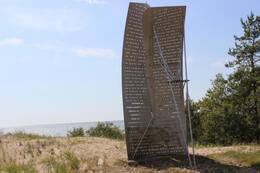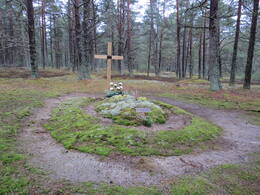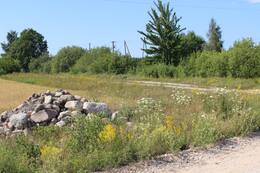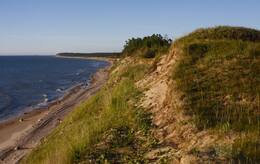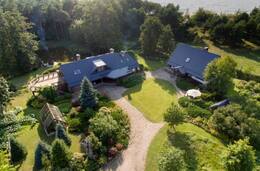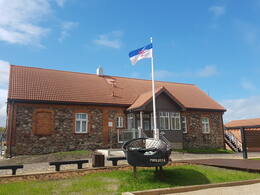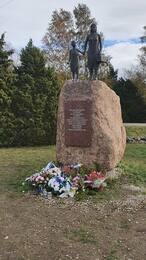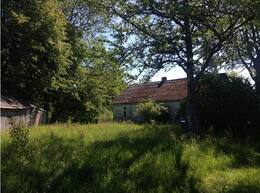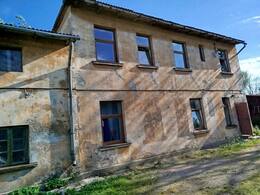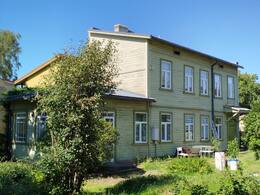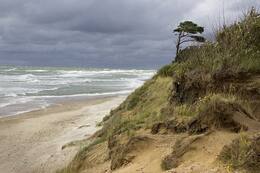Refugee boat transfer point from the Kurzeme coast to Sweden near the "Pāži" houses
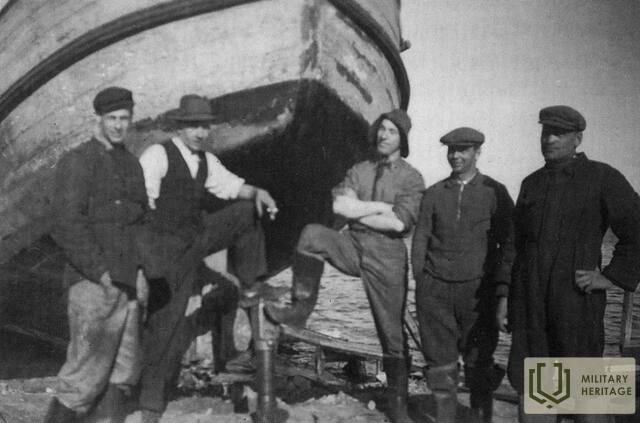
One of the important places of relocation was near the “Pāži” house, where a monument has now been erected - “Sail of Hope”. “The ships came regularly and the most people left from “Pāži”, says the memories of I. Freibergs.
“In order to make the journey safer, the “Pauriņi” house in Sārnate, run by the Bērzkalns family of Latvian patriots, was chosen as the LCP headquarters. The sons Arturs and Gusts were particularly active. The LCP activist and journey organizer Kārlis Frišenfelds stayed at “Pauriņi” the most, and also the courier Leonids Siliņš periodically. [..] A small boat arrived from Sweden at night and anchored in the sea with the calculation that it would not run aground, but could immediately escape in case of danger. The refugees were brought from the coastal ships in rowboats. This dangerous work was undertaken by three fishermen from Sārnate, Jāzeps Sūniņš and the brothers Antons and Krišs Priedoliņi. [..] The relocation headquarters was set up in “Pūņi”, because it was close to the sea, but in a remote place. Many people came here, a pot of lingonberry was constantly boiling on the stove, so that would be able to gain the favor of the coast guard - Lithuanian and German command. The place of relocation was near the "Pāži" house, where a monument - "Sail of Hope" is now erected. The ships came regularly and the most people left from "Pāži".
I.Freibergs. Sārnate - the secret capital of Latvia. 1944-1945. Kuldīga, 2005.
Related timeline
Related topics
Related objects
Memorial sign for refugees "Sail of Hope" in Jūrkalne
The "Sail of Hope" commemorative sign for the World War II refugees who crossed the Baltic Sea by boat to the island of Gotland in Sweden in 1944 and 1945. The memorial is located in Osvalki on the dunes between the sea and Ventspils-Liepaja highway, near the public transport stop "Kaijas". It was created by sculptor Ģirts Burvis, who realised it as a sail of hope symbolising the memory of Latvian refugees.
Between autumn 1944 and spring 1945, fearing the renewed Soviet occupation but unwilling to evacuate to a devastated and threatened Germany, some Latvian citizens tried to reach the nearest neutral country, Sweden, by sea. Some of the boats were organised by the Latvian Central Council with the help of the Western Allied countries, which resulted in one of the largest refugee concentration points in Jūrkalnes parish. Besides the boats organised by the Latvian Central Council, other boats were also taken across the sea. It is estimated that about 5000 persons managed to cross the sea. The number of deaths is unknown, as no records were kept of refugees leaving the Kurzeme coast.
The voyages were dangerous because the refugees were threatened by German patrols on the coast and at sea, sea mines, Soviet aircraft and warships, as well as storms, as the crossings often took place in unsuitable and overloaded cutters and boats without sufficient fuel and food supplies, sea charts and navigational instruments. Departures from Latvia were carried out in secret. The destination of the boats was the island of Gotland, and the journeys most often started on the west coast of Courland (from Jūrkalne to Gotland is 90 nautical miles or about 170 kilometres as the crow flies).
Lithuanian soldiers' graves in Zaļkalns Forest
The memorial is located near the Pāvilosta beach lookout tower in the dunes. There are signs pointing to the memorial.
At the end of the Second World War, three Lithuanian police battalions, the 5th, 13th and 256th, were also deployed in Latvia, and after guard duty and fighting against Soviet partisans and the Red Army on the Eastern Front, from autumn 1944 they were involved in guarding the Baltic Sea coast in Kurzeme.
In October 1944, all three battalions, consisting of 32 officers and about 900 instructors and soldiers, were subordinated to the German 18th Army's 583rd Rear Guard Unit (Koruck 583). The unit was tasked with guarding the Kurzeme coast from Liepāja to Ventspils. All three Lithuanian battalions were deployed in the vicinity of Pavilosta. In December 1944, the 13th Battalion was transferred to the German 1st Army Corps at the Liepaja Lake.
One of the tasks of the Lithuanian coastguard, besides being ready to fight enemy landings and to report enemy ships, was to prevent Latvian refugee boats from sailing to the island of Gotland, 160 kilometres away, but the Lithuanian coastguard men did not prevent the refugee boats from leaving. However, news of the Lithuanian coastguard helping the Latvian refugees and the Lithuanians themselves preparing to cross the sea to Sweden also reached the Germans.
On 10 January 1945, the soldiers of the 1st Company of the 5th Lithuanian Police Battalion were rounded up. More than a week of interrogation and trial followed, which, as a warning to the others, decided to execute seven of the Lithuanian soldiers and to imprison 11 of their comrades in concentration camps in Germany. The execution of the seven Lithuanian soldiers (Sergeant Macijauski, the company commander; Juozas Sendrjuas, a soldier; Vladas Salickas, a soldier; Ionas Bašinskis, Krasauskas and two unknown others) took place on 21 January 1945 in the Zaļkalns Pines in Pavilosta.
In January 1945, the 5th Battalion was disbanded and the combat-ready soldiers were divided into the two remaining battalions, while the rest were formed into a separate sapper company. At the time of the surrender of Army Group Kurzeme in May 1945, two battalions (13th and 256th) were still in Kurzeme as a sapper company with a total of 900 soldiers who were taken prisoner by the Soviets.
The road to the "Grīnieki" house in Vārve parish
The road to the “Grīnieki” houses in Vārve parish, where in 1944 one of the main settlements for boat refugees on the Kurzeme coast was located.
Memories of boatman V. Jurjakas: “Entering the “Grīnieki” yard, everything looks very normal. A quiet country house, not a soul, probably people in the sun. [..] It turned out that not only the “Grīnieki” residential house was full of people, but all the buildings were full. The barn, the granary, the hayloft and the bathhouse. I met one or two acquaintances, because it was time to leave our land. [..] The nutritional situation was not critical, but quite poor. [..] In the evening, the refugee caravan began to move towards the seashore. I warned everyone in advance not to come out of the bushes by the seashore, because there were coast guard dugouts and observation posts nearby. It was a large caravan, because about 200 people were going to the seashore. There was no hope that everyone would arrive on time. The evening was not very dark, and I was able to review the activities of the entire group. The most striking were the large "When people lived in "Grīnieki", they didn't see them, but now, when they were brought into the light, they only saw this. The goods alone required a whole boat. 3-4 two-horse carts were loaded with goods, followed by people. [..] We waited for the boat for a long time, but it didn't come. The whole caravan had to turn back. It was very dark."
Temporary refugee shelters "Vārves būda"
"Vārves būdas", a place in Ventspils municipality that served as temporary housing for Latvian refugees who were waiting for boats from Gotland to arrive in 1944.
Memories of the boatman V. Jurjaks:
“My half-brother and his family had come to us from Riga, and when the news came that a boat was expected at Vārve, I united these people of mine with the group of police chief Jasūnas and we all set out for Vārve. We waited for the signals until late at night, but the boat did not arrive. We waited there like that for a whole week. It started to rain. People made tents out of sheets, so we called this place “Vārve huts”. My wife and I spent more time in Ventspils during the day, and eventually we had to think about how to deliver food to those waiting. I remember one night my wife and I were carrying hot boiled potatoes through the forest for them on our bicycles. It was raining heavily, lightning was roaring, and the warm potatoes tasted good to the waiting people who had spilled out. The Vārve forester had accidentally discovered this hiding place, but - promising him the possibility of a transfer, he came to help. The Germans had begun to go through the houses of the coastal residents, looking for people in the years of conscription. Two young people had been caught in the forest near the “Vārve huts”. Therefore, this place could no longer be safe for these more than fifty people who were languishing here.
"Bambaļi" houses - one of the main accommodation places for boat refugees
The restored “Bambaļi” houses in Ošvalki, Jūrkalne parish, which in 1944 was one of the main places of accommodation for boat refugees on the Kurzeme coast.
Memories of boat refugee Kārlis Draviņš: ““Bambaļi” were old, small, very run-down houses in Jūrkalne parish, about 40 kilometers from Ventspils. [..] Small fields spread around in a damp place, but on the other side an old, overgrown dune wrapped itself around it. The sea gurgled a little behind it - the houses were right next to the sea. On the other side, half a kilometer away, the Pāvilosta-Užava highway ran, but the road to the houses was not easy to drive on, which is why the Germans could not be everyday guests here. The place where boats were waiting was easily accessible - a small forest clearing on a high bank. [..]
The owner of "Bambaļi" and her group, who were also waiting for the "movement of the water", lived in two rooms facing the sea, but the group of refugees lived at the other end of the house, also in two rooms. They shared the kitchen. The hallway between the two ends was stuffed with the refugees' many belongings. The rooms were filled with straw, which was spread out along the walls. On each side of the room was one bed, where a mother and her children slept. The straw beds were covered with sheets or something else during the day. They came out to sit or sleep in them during the day, because there was nowhere else to stay. [..] The days passed monotonously, one after the other. They got up on command, there was no hurry. When the communal breakfast was eaten, some went to play cards, some took up fortune-telling, while others tried to read. Some had to do household chores - fetch firewood, water.
Pāvilosta local history museum exposition
Named ‘Pāvilosta, a Closed Area’, the exhibit in the Pāvilosta Local History Museum is about everyday life in the town of Pāvilosta during the Soviet occupation; specifically, about the executive branch, border area, fishermen’s collective farm, and the cultural and social activities. In addition to the permanent exhibit, there is an interactive and emotionally rich digital exhibit in two languages and an audio-visual installation offering a film about Pāvilosta.
The museum also features a new exhibit named ‘The Golden Sand Grains of Pāvilosta’. The digital installation showcases old events, how Pāvilosta was founded and the most important developments from 1918 to the present day. Military heritage is a point of focus in the War of Independence section, which tells a story about the freedom fighters of Latvia and the time of the Soviet occupation.
Monument to those who fled across the sea to Sweden in 1944
This monument is situated on the water’s edge on Cape Puise. In 1944, around 80,000 people fled westward from the advancing Red Army, many of them by sea. This monument, commemorating that mass flight, was designed by Aivar Simson. The idea originated from Heidi Ivask, who, held in her mother's arms, was one of many who waited for a boat on the beach in Puise. Construction of the monument was led by the Estonian Memento Union.
"Laukgaļi" houses, the residence of the writer Kārlis Skalbe
“Laukgaļi” in Jūrkalne parish, the place where writer Kārlis Skalbe stayed in October - November 1944, while waiting for a refugee boat to Sweden.
Writer Kārlis Skalbe (1879–1945) was a member of the Latvian Provisional National Council and the Latvian People's Council, a deputy of the Constitutional Assembly of the Republic of Latvia and the 1st and 4th Saeima. During the German occupation, he was the editor-in-chief of the literary magazine "Latvju Mēnešraksts", one of the signatories of the LCP memorandum of March 17, 1944.
On November 11, 1944, she fled to Sweden. She died in 1945 in Stockholm.
The building in Ventspils where LCP liaison Valentine Jaunzeme (Lasmane) lived in 1944
The house at Lauku Street 4, Ventspils, was home to the teacher Valentīne Lasmane (nee Jaunzeme) (1916–2018). She was a liaison officer for the Latvian Communist Party and a member of the Ventspils liaison group. After World War II, she lived in Sweden.
She compiled the testimonies of 130 boat refugees in the publication “Across the Sea 1944/1945” (Stockholm, 1990), but V. Lasmane's own life story can be read in the book “Night is No Longer Just for Sleeping” (Riga, 2020). In 2000, she was awarded the Order of the Three Stars. She died at the age of 102 in 2018 in the Stockholm suburb of Täby.
The building in Ventspils where Dr. Valdemārs Ģinters, a representative of the Latvian Communist Party and organizer of refugee boat traffic in Kurzeme, lived in 1944-1945.
The house at Katrīnes Street 4, Ventspils, where archaeologist Valdemārs Ģinters worked.
From October 1944 to May 8, 1945, the LCP representative in Kurzeme was archaeologist Valdemārs Ģinters (nicknames “Doctor”, “Gardener”) (1899–1979). Participant in the Latvian War of Independence, director of the State Historical Museum and docent at the University of Latvia. Awarded the Lāčplēsis War Order and the Three Star Order. One of the signatories of the LCP memorandum of March 17, 1944. After World War II, he lived in Sweden. From 1949 to 1979, he was chairman of the board of the Latvian National Foundation.
The steep bank of Staldzene, from which refugee boat traffic to Sweden took place in 1944
In 1944, there was active refugee boat traffic from the Staldzene cliffs to the shores of Sweden.
Ž. Lapuķis' memories of meeting with Dr. E. Bakusis:
“One afternoon, a local police officer came to me and quietly told me that a boat from Sweden was expected to arrive that night near the village of Staldzene near the Koku hills to pick up refugees. My task was to come with a group of guards from my unit to guard this place and, if necessary, help to transport the refugees to the motorboat. [..] Not far from the sea, without waiting, a man stood in front of us on the rope, wearing a gray half-coat with a turned-up collar and a jockey's hat pulled low on his forehead. He said a quiet good evening and asked: “Is this the road to Lošupi?” That was the watchword for Swedish riders in that place. He said that he was here on a special mission, but at the same time he would like to get his family to Sweden safely. Then, to my great surprise, he pulled out our forestry plan from his pocket. In the twilight, I began to watch the stranger's face and soon recognized him. It was Bakūzis, the head of the Forestry Department's Forestry Management Division [..] It was approaching midnight when we saw a black dot in the distance in the sea. We gave the agreed signal with a flashlight, repeating it several times. After a short while, the same answer came from the black dot, only it was not from a flashlight, but the light transmission of a warship. We realized that the boat was no longer expected that night and the group of refugees was starting to disperse. Bakūzis invited us both with the company commander to stay with his family. We found it in a hollow in the dunes under a thick fir tree. There, in the green moss, with their heads resting on a white pillow, three offspring of this family were lying in a deep sleep, and next to them, with a white scarf around their heads, sat the caring mother of the house. The father of the house found a bottle and the mother of the house offered sandwiches. It seemed that with their Latvian sincerity they were the real father and mother of the house, who had found their home on this rainy autumn night under the fir tree of their homeland. On one side the sea hisses, on the other a forest massif and heavy raindrops slowly fall through the branches of the fir tree. We emptied the bottle, but refused the sandwiches, because we realized that they needed them more themselves.
The Mazirbe coast, from where refugee boat traffic to Sweden took place in 1944
The Mazirbe coast was an important place during World War II, from where refugee boat traffic to Sweden took place in 1944.
Memories of boat refugee Ilona Cīrule (nee Mālītis): “I was 13 years old at the time. I remember that at the end of September we traveled in a caravan from Riga to Mazirbe for a whole week. The trip remains in my memory as something unpleasant: the Russian candles in the sky worried me to the core. We lived in Mazirbe for about three weeks, and every day I heard talk about crossing over and about looking for boats. Finally, on October 21, we had to get ready. [..] There were about 90 of us on the boat. I sat on my father’s lap on the deck. The small children with their mothers were below, and they were short of air. I must have been dozing, but in the morning of the next day a plane was spotted and a ship on the horizon. Then the people became quiet. In the afternoon, the ship came again, and this time it came right at us. But it happened like in a fairy tale: it was a Swedish military ship! They pulled us all onto the ship, gave us warm cocoa and took us to the port of Nynashamn. Our boat was tied to the ship and its owner Zariņš-Petravs received it safe and sound. Among the guests were Šici, Zanderi, Vanagi, the former Minister of Justice Mrs. Apsīša, our family and others. I know that the boat had to be paid in gold. But how much - I don't know.





